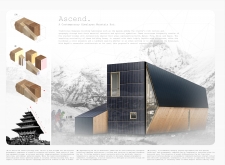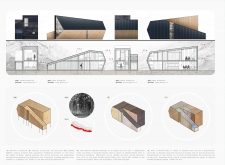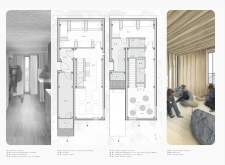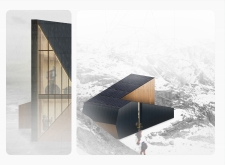5 key facts about this project
At its core, the project aims to create a harmonious living or working space, inviting interaction and fostering community. Through a well-considered layout, the design facilitates movement and access, ensuring that spaces flow logically from one to another. Key areas such as communal gathering spots and more intimate private quarters are carefully delineated, enabling a variety of uses and experiences within the same structure. This spatial organization encourages social engagement, making it not just a building but a vibrant part of the community fabric.
One of the most distinctive features of this architectural design is its exterior facade, which harmonizes with the surrounding environment. The choice of materials plays a crucial role in achieving this effect. The use of local stone and sustainably sourced wood not only enhances the visual appeal but also anchors the building within its geographical context. These materials are thoughtfully arranged to create texture and depth, contributing to the overall character of the project. Large windows punctuate the facade, allowing natural light to penetrate deep into the interiors while offering panoramic views of the landscape. This connection to the exterior environment is an essential aspect of the design, promoting a sense of well-being and fostering a connection with nature.
Inside the project, careful consideration is given to both aesthetics and functionality. The design incorporates open-plan spaces that encourage interaction and flexibility. The interiors feature a cohesive color palette, promoting calmness and clarity throughout the spaces. Each room is tailored to fulfill its purpose while maintaining a sense of continuity with the rest of the building. Significant attention has been paid to the selection of furnishings and fixtures, ensuring they complement the overall design narrative without overpowering it.
Sustainability is a vital consideration in this project. Incorporating energy-efficient systems, such as solar panels and rainwater harvesting, reflects a commitment to environmental responsibility. The architecture thoughtfully integrates these features into the design, ensuring that they enhance the user experience without detracting from the aesthetic qualities of the project. This approach not only reduces the ecological footprint but also serves as an educational tool for occupants and visitors, demonstrating the feasibility of sustainable living.
Unique design strategies have been employed to ensure the project is both inviting and functional. The incorporation of green spaces, whether in the form of courtyards, green roofs, or landscaped gardens, allows for an interplay between the built environment and the natural world. These outdoor areas serve as extensions of the indoor spaces, offering residents and visitors alike a place to relax and enjoy the surroundings, further emphasizing the project’s connection to its site.
The architectural plans reveal a meticulous attention to detail, illustrating how each aspect of the design contributes to the overall narrative. Structural elements are not merely functional; they are integrated into the aesthetic considerations of the project. Architectural sections demonstrate the thoughtful layering of spaces and materials, showcasing how light, air, and movement interact within the design.
Ultimately, this architectural project is a testament to thoughtful design, where each decision reflects a careful balance of form, function, and environmental awareness. The commitment to creating spaces that are not only beautiful but also practical resonates through various elements of the design. For those interested in a deeper insight into this project, exploring the architectural designs, plans, and sections will provide a fuller understanding of the intentions and philosophies that shaped this remarkable architectural endeavor.


























